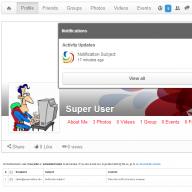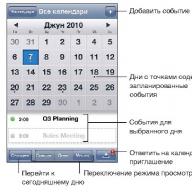Today we will talk about different ways installing fonts in Windows 7. This procedure, it would seem, should not cause any special problems for system users and administrators, but it also has its pitfalls. Let's try to figure out how to install a font in Windows 7, I will give several methods, as the complexity increases. Naturally, we assume that you have already downloaded the new font and, if it was in the archive, you unpacked it. Let me remind you that the font file has the extension .ttf.
Installing a new font inWindows 7
To install a new font, just right-click on the ttf file and select " Install" (Install)

A window will then appear showing the installation progress.
Another way to install fonts is that you need to open the Font Control Panel ( ControlPanel\AllControlPanelItems\Fonts) and simply drag & drop the font file into this window.

If you need to install several fonts at once, you can just as easily select them with the mouse and drag them onto the panel.
There is another interesting option for adding new fonts to Windows 7. If there are a lot of new fonts, but there is not enough space on the system disk, you can install fonts using shortcuts. To do this, in the font control panel on the left, click on the item “ FontSettings» (Font settings) and in the window that appears, check the box "Allow fonts to be installed using a shortcut (advanced)"(Allow installation of fonts using shortcuts). In this case, Windows will use the new font directly from the directory in which it is located.

Now, if you right-click on a font, an additional menu item “ Install as shortcut» (Set as shortcut).

Bulk installation of fonts inWindows 7 script
Let's imagine a situation where you need to install several dozen fonts on several computers at once. Naturally, doing this manually is very long and tedious. Is there a way to automate the installation of new fonts in Windows 7. Luckily there is!
In the days of Windows XP, to install a font, you simply had to copy its file to the C:\Windows\Fonts directory. In Windows 7, this trick will not work, and although you can say that just above we are using Explorer to copy the file with the font to the C:\Windows\Fonts directory, I will object by saying that it is not so simple. When you copy a font using Windows Explorer, it's not just copying. The system detects that a new font is being copied and automatically starts installing it on the system, which is why a pop-up window appears with the text “Installing”.
To install fonts in Windows 7, you can use a VBS script file. Let's say we have a directory c:\install\font that contains the font files that need to be installed. We create a new file on disk with the vbs extension (for example, batch_install_font.vbs), copy the specified code into it and run it as a regular program:
Set objShell = CreateObject("Shell.Application")
Set objFolder = objShell.Namespace("c:\install\font")
Set objFSO = CreateObject("Scripting.FileSystemObject")
For Each FontFile In objFolder.Items()
Set objFolderItem = objFolder.ParseName(FontFile)
If Not objFSO.FileExists("c:\windows\fonts\" & FontFile) Then
objFolderItem.InvokeVerb("Install")
End If
Next
As a result, a sequential installation of new fonts from the directory will begin c:\install\font into the system and for each of them a window will appear with a progress bar. 
If these fonts are already installed in Windows 7, then they will not be installed again.
Windows 7 comes with dozens of attractive and professional-looking fonts. However, there are even more unique, attractive and fun fonts available for download all over the internet.
If you're creating your own document, publication, or other design with text, using a new font can make it stand out. Even better, when you discover how easy it is to add fonts to Windows, you can install them all.
Learn how to install fonts on Windows 7 using several methods, and how to remove them if you change your mind.
Adding fonts securely in Windows
As with any file or software of any type that you download onto your computer, you need to be sure that any fonts you install are safe.
- Look for fonts on reputable websites or as part of curated lists on a website you trust.
- Also, make sure you click the correct download button. Ads containing misleading graphics that resemble download buttons may trick you into installing something potentially dangerous.
Note. A good place to look for fonts that you know are safe is the Microsoft Typography page. You'll also find a lot of information about current and developing Microsoft fonts.
Unzip the font file
In most cases, new fonts will be downloaded to your computer as ZIP files. Before you can add fonts to Windows, you must unzip or extract them.
- Navigate to the font file you downloaded, which is most likely located in your Downloads folder.
- Right-click the folder and select Extract All.
- Select the location where you want to save the extracted font files and click Extract.
How to install fonts in Windows 7 from the fonts folder
Fonts are stored in the Windows 7 fonts folder. Once you download new fonts, you can also install them from this folder.
- To quickly access the folder, click Start and select Run, or press and hold the Windows key and press R. Type (or paste) %windir%\fonts into the Open field and click OK.
- Go to the File menu and select Install New Font.
- Navigate to the location where you saved the extracted font.
- Click on the file you want to install (if there are multiple files for the font, select the .ttf, .otf, or .fon file). If you want to install multiple fonts, press and hold the Ctrl key while selecting files.
- Select "Copy fonts to fonts folder" and click OK.
How to install fonts from a file
You can also install fonts in Windows 7 directly from the downloaded font file after extracting it.
- Navigate to the font file you downloaded and extracted.
- Double-click the font file (if there are multiple files in the fonts folder, select the .ttf, OTF, or .fon file).
- Click "Install" at the top of the window and wait a minute for the font to install on your computer.
Removing fonts
If you decide you don't like the font, you can remove it from your computer.
- Go to the Fonts folder."
- Click the font you want to remove and click Remove (or choose Remove from the File menu).
- Click Yes if a prompt box appears asking if you want to remove the font(s).
With the development of digital technology, great opportunities have opened up for the user in various business structures. New movements of music, paintings and other art began to appear in society. Modern life has become more colorful and dynamic. The very idea of presenting information has especially changed. People stopped seeing the same font in books, posters, posters and advertisements. Now it is possible to convey the mood and atmosphere using letters.
But many operating systems installed on a computer (for example, Windows 7) have a meager set of “letter styles”. Naturally, many users are puzzled by this question of how they can be installed.
This article describes in detail how you can install various fonts in the Windows 7 operating system. Moreover, to add this data, you do not need to have third-party programs on your computer for this. To replenish the “beautiful alphabet”, the internal resources of the system itself will be sufficient.
To add different fonts in the Windows 7 operating system, you can use two methods
But first you need to download the necessary files from the source. Windows 7, like newer operating systems, works with OpenType and TrueType styles. As a rule, this data has the extension *.ttf and *.otf. When PC owners see these files for the first time, they will not confuse them with anything. The system displays *.ttf and *.otf as a blank sheet on which you can preview the downloaded font.
Having downloaded the archive where the fonts are stored or uploaded it as a separate file, the user must hover over the required mouse cursor and press the right button. After this, Windows will provide a choice in the form of a context menu, where you will need to select the “Install” item.
Microsoft operating systems are designed to make life easier for ordinary users. So in our case, in order not to waste time with each file in Windows, it is possible to install several at once. To do this, select the required quantity, right-click and select “Install”.
There are times when the usual method does not help to add the desired font. At the same time, the PC owner is sure that he has a working working file with the required *.ttf and *.otf extension. To still add the desired style, you can use the following method.  To do this, copy the necessary data and go to the specified path “C:\Windows\Fonts”. This is where the OS stores all installed fonts, so this is where you should save the file.
To do this, copy the necessary data and go to the specified path “C:\Windows\Fonts”. This is where the OS stores all installed fonts, so this is where you should save the file.
After all the actions, the user can see these alphabet styles in various text editor programs (MS Office, OpenOffice, etc.), which take them from the above-described location in the OS. Applications also have their own set, which during the installation process puts their styles in this folder.
To view the entire set in Windows 7, the user needs to click the “Start” button, then select the “Control Panel” section and select “All Control Panel Items” in the menu that opens. In order not to waste time, you can also use the search. In the Control Panel at the top, enter “fonts” in the search field and press Enter. By selecting the line that appears, you can see the entire list of letter styles in the system. Here you can, if necessary, delete or hide the selected data.
If the font does not install
During installation, users may encounter various difficulties and errors. Here, the main thing is not to despair, because they all have a simple solution. The most common problem of all arises from the fact that the user cannot complete the installation, and the OS displays an error of this kind on the screen: “This file is not an operating system font.”
There are times when a PC owner, having downloaded a style he liked from a website, sees that the file has a different extension (does not have the required *.ttf and *.otf format). These styles are suitable either for other operating systems or are used by individual programs. In order not to look for a similar one and not waste time on this, you can use special free services that are located on the Internet. They can convert from other font formats to the one required for installation in the Windows operating system.
The need to install new fonts yourself does not arise often. Usually this is required only for those who are involved in document preparation or are involved in printing work.
Generally speaking, Windows 7, unlike its predecessors, automatically registers fonts when their files are placed in the folder \Windows\Fonts, and does not require a special installation procedure. However, it is still better not to use this technique. Firstly, the name of the font does not match the name of the font file, and therefore it is not always clear what exactly was installed in this way. Secondly, the description of some fonts (for example, Type 1 fonts) is stored in several files, which can cause errors when copying manually. So it's better to act methodically.
Installing fonts:
- Open the fonts folder (Start Control Panel - Fonts). Give an icon.
- Give the command: File install font and the Add fonts dialog box will open.
- Specify the drive and folder containing the required font files. This performs a search and generates a list of available fonts. Depending on their number, the procedure may be lengthy.
- Select the required fonts from the generated list, check the Copy fonts to the “Fonts” folder box and click the OK button. The process of copying new fonts will begin and register them simultaneously.

If the font is already installed, it will not be replaced by the new version. You must first remove the old font and then install the new one as usual. Deleting fonts is the same as deleting any files. If the Windows 7 operating system is installed, no special precautions are required.
Font coding system
Each character in any font has a numeric code associated with it. Over the years, text character encoding has come a long way from five-bit encoding (32 distinguishable characters) to six, seven, eight-bit and then sixteen-bit.
Eight-bit coding, introduced in the early 60s of the last century, has been in practice for the longest time. It allows you to encode sets of up to 256 characters. Such a set, before using the font (it needs to be installed), can cover numbers, punctuation marks, generally accepted symbols and letters of one or two national alphabets.
However, with the development of the Internet and other means of communication, the level of international communication has sharply increased, and eight-bit coding no longer meets modern requirements. It was replaced by a new standard - Unicode. He assigned a unique sixteen-digit number to each character of various national alphabets. All OrepTure fonts, as well as some True Type fonts, comply with the Unicode standard.
In the literature one can often find a superficial judgment that Unicode is a double-byte encoding system. In fact, this is not entirely true, because sixteen bits of a symbol’s sequence number are not always represented by a pair of bytes. They can be represented by one, two, three, and in some cases four bytes. The number of bytes in a character encoding is determined not by the Unicode encoding system, but by the associated mechanism for converting bits into bytes, which is called UTF (Unicode Transformation Format).
- If you apply the UTF-8 conversion mechanism, then English characters will be written in just one byte. This is possible for them because they occupy an honorable first place in the Unicode table (the most significant bits in the 16-bit notation of the character number are zero, and they are simply discarded).
- Slightly worse than Russian and other European languages. Their symbols cannot be written in one byte - only two. And the characters of eastern languages have to be written in three bytes. This mechanism is most beneficial for England and the USA and is not beneficial for Japan, China and Korea.
- If we apply the UTF-16 conversion mechanism, then all characters of all languages will be written in exactly two bytes. This mechanism is most beneficial for China, Korea and Japan and least beneficial for England and the USA. Russia and other European countries do not care which mechanism to use: UTF-8 UTF-16.
- There is also a TF-32 mechanism that converts the character code into four bytes, but this is a special operation for special characters,
- For the benefit of email, the TF-7 mechanism was developed, which converts the 16 bits of the character number into eight-bit octets in which the 7 least significant bits are significant. The number of octets received depends on the language in which the message is written. The point of conversion is to optimally prepare the text for transmission and to forestall clumsy attempts by mail systems to apply their own byte conversion algorithms.
So, for example, a Chinese character encoded with UTF-16 encoding is represented as two bytes. In this encoding, mail systems will represent each byte as two and ultimately send 4 bytes, while in the encoding, a character could be immediately represented by three bytes, without requiring additional recoding. This saves system operating time and reduces the load on communication lines.
In some cases, the user needs to change the standard font to another or install a new one. There may be several reasons for this. Perhaps you like the other one better and it is more convenient to read, or the program does not work with the standard ones, in which case you have to install additional ones.
There are several types of fonts:
- The first one is TrueType. It can be set to absolutely any size, without losing its clarity and display quality; they can also be easily printed using system devices.
- OpenType– Supports rotation and scaling while maintaining display clarity. It can also be printed using standard utilities.
- Technology ClearType designed to display text on LCD monitors, where they look much better.
- PostScript– developed by Adobe Systems. They are distinguished by high quality and detail.
It is worth noting that these instructions for installing fonts are relevant for Windows 7, 8, 10.
Where are the fonts and how to find them
There are several ways to find the fonts currently installed on your device. The first method involves acting directly via conductor. To enter the directory, the user will need to follow the path C:\Windows\Fonts, this folder will contain files with all installed varieties. In order not to search for the directory yourself, you can press win+r and enter %windir%\fonts in the window that opens.
The second method involves using control panels. In this case, you need to launch it through Start, after which you will only have to find the Fonts section.
You can also simply enter the desired name to the search bar, then open the found directory. 
Installation procedure
Here we will indicate some of the simplest and most effective ways to install fonts.
In the first method, the user will need to navigate to the downloaded file and right-click on it. Next you should click on the line Install, which will be available in the pop-up context menu. 
In the second method, the user will need to get into fonts folder, several ways to do this were described in the previous section. Next you need to click on the File menu item and select the section Install font. In the window that opens, specify the path to the downloaded file.
The third method involves simply dragging and dropping a downloaded file to the standard folder. 
Installing fonts with a shortcut
If the user has little space on the system disk, but there is a need to install new fonts, they can be installed as shortcuts. To do this you will have to do several steps. To begin, the user will need to log in via control Panel to the required utility. Then, on the left side of the menu that opens, select Options.
In this menu, check the box that allows installation as shortcuts.
Now, after clicking on the downloaded file, an additional line will appear in its menu, which will allow you to install the windows font as a shortcut.  In this case, the downloaded data will not be copied to the standard folder, however, if the original file is moved to another location, the font will no longer be available and will have to be installed again.
In this case, the downloaded data will not be copied to the standard folder, however, if the original file is moved to another location, the font will no longer be available and will have to be installed again.
How to remove or hide a font
To delete or hide a font, just go to the folder where they are all stored. After this, you can right-click on the unnecessary file and click “ Delete" This will completely erase the file from the system. If the user wants some of them to simply become unavailable, then you can select the “ Hide", which will save them on the device, but make them inaccessible in editors.
Do not forget that there are several elements without which the system will not be able to work or will fail. Here is a list of files that should not be deleted under any circumstances:
- Courier New
- Arial(including options: Bold, Italic, Bold Italic);
- Times New Roman(including options: Bold, Italic, Bold Italic);
- Symbol;
- Wingdings;
- MS Serif;
- MS Sans Serif.
How to install a custom font
If the file has a non-standard extension or type, the system may complain about it. In this case, you should still try to install it; if this fails, you will be left with download data in a format that the system understands.
It is also possible to use one of the online programs for file type conversions, which are now available on the Internet, you should search for “ps to ttf”, simply replacing the first item with your file extension. After this, you can try to install the converted file.
What to do if the font is not installed
What to do if the system complains that the file is not a font file is described in the previous section. It's worth using a converter or downloading it from another location. However, there is one more nuance. For dozens of users, even obviously working files may not be installed if built-in firewall disabled. If you activate it, the information is installed perfectly; all Windows 10 users should try this method if the installation fails.




